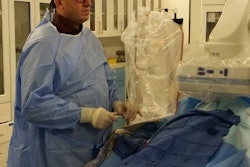
In May 2017, I lost my wife and colleague, Dr. Amy Josephine Reed, to a uterine soft-tissue sarcoma. This cancer was iatrogenically spread throughout her abdomen using a gynecological technique known as "morcellation" during the course of her uterine resection operation. Dr. Reed ultimately succumbed to compartment syndrome from iatrogenic abdominal sarcomatosis.
The unfortunate fact is that despite several clear red flags, Dr. Reed's gynecologists assumed her tumors were benign in the preoperative evaluation of her symptomatic tumors -- an assumption that a large proportion of gynecologists, in the U.S. and abroad, continue to make when offering women nononcological uterine resection operations.
Not surprisingly, Dr. Reed was not the only woman who has experienced this unacceptable and catastrophic complication. The U.S. Food and Drug Administration (FDA) and other credible epidemiological researchers ultimately found that upward of one in 350 women undergoing nononcological uterine operations for uterine tumors -- assumed benign -- carry a potentially deadly malignancy. In December 2017, the agency reaffirmed its guidance against using laparoscopic power morcellators to remove fibroid tumors in the vast majority of women.
A 'dangerous deficit'
As time has passed, I and many colleagues have had the opportunity to use Dr. Reed's complication, and her suffering, to undertake an extensive root-cause analysis of this tragedy so that we might protect others in her position -- and, perhaps, to create meaning from her experience.
 Dr. Amy Josephine Reed in 2011, a member of the faculty and an attending physician at Beth Israel Deaconess Medical Center. Image courtesy of Dr. Hooman Noorchashm, PhD.
Dr. Amy Josephine Reed in 2011, a member of the faculty and an attending physician at Beth Israel Deaconess Medical Center. Image courtesy of Dr. Hooman Noorchashm, PhD.The issue is that there is a serious and dangerous deficit in the radiological workup of uterine tumors.
During the course of Dr. Reed's preoperative evaluation, she underwent several uterine ultrasound evaluations. In addition, she underwent a preoperative MRI study. These studies, in retrospect, all demonstrated concerning features.
However, because of the absence of radiological vigilance and the deficit in an adequate scoring system, not a single radiologist involved in reading Dr. Reed's images raised the specter of a potential malignancy. Of course, this deficit is quite systemic in radiology, despite the fact that an occasional radiologist may feel compelled to comment on concerning findings.
Certainly, radiologists at the time of Dr. Reed's preoperative evaluation did not feel at all compelled to comment -- neither on her large uterine tumors, nor on their rate of growth or the extensive central necrosis clearly visible on both MRI and ultrasound studies.
We are left wondering: What if an astute radiologist had raised the specter of a potential malignancy? What if radiology had a standardized scoring system in place to assess the likelihood of uterine tumors being malignant?
Of course, such a scoring system is well-known to all radiologists, especially in the case of women's health. Specifically, I am referring to BI-RADS, which is used for screening and risk stratification of women's breast masses, the majority of which, like uterine tumors, turn out to be benign.
I believe the BI-RADS model provides the necessary road map for creating a safe algorithm for screening of uterine masses in women.
I'm sure you are aware of the recent report by the U.S. Centers for Disease Control and Prevention (CDC) on the incidence of uterine malignancies. The number of women potentially affected by uterine tumors in the U.S. is not negligible. Yet there are no standardized diagnostic/imaging algorithms for evaluating and scoring uterine tumors in radiology.
I was amazed to find that by using simple noninvasive screening ultrasound, radiologists and ob/gyn physicians might be able to generate a robust and standardized screening algorithm for uterine tumors. Such a system could primarily be based on relatively inexpensive and feasible ultrasound imaging of the uterus.
This ultrasound-based system would require the implementation of routine uterine screening of all women 35 to 65 years old, perhaps once every two to five years, similar to the routine mammogram screening regimen in place for breast cancer.
For your consideration, similar to BI-RADS, the proposed Uterus Imaging Reporting and Data System (UI-RADS) could read something like the following:
- UI-RADS 0: Need further imaging because of poor-quality study
- UI-RADS 1: Normal uterus, no masses
- UI-RADS 2: Uterine tumor present, benign (single tumor, < 5 cm, no necrosis, echogenicity consistent with benign fibroid)
- UI-RADS 3: Uterine tumor(s) present, cannot be classified as most likely benign (multiple tumors, size 5-10 cm, no central necrosis, indeterminate echogenicity)
- UI-RADS 4: Uterine tumors(s) present, concerning findings for malignancy (multiple tumors, size > 10 cm, < 10% central necrosis present, indeterminate echogenicity)
- UI-RADS 5: Uterine tumor(s) present, most likely malignant (multiple tumors, size > 10 cm, > 10% central necrosis, echogenicity consistent with malignancy)
- UI-RADS 6: Uterine tumor(s) present, previously established malignancy present
A woman's UI-RADS grade can then be assessed for its "concordance" with clinical and, potentially, pathological findings to determine the necessary clinical action.
Each of these classifications would lead to the following clinical actions by the gynecologist:
- UI-RADS 0: Repeat imaging
- UI-RADS 1: Routine screening
- UI-RADS 2: Follow-up imaging at one year; if unchanged, proceed with routine imaging follow-up. If growing > 50% in one year, upgrade to UI-RADS 3. If clinical symptoms require myomectomy, perform with intraoperative biopsy to establish a reasonable assurance of benignity before surgically violating the uterine capsule. If clinical symptoms require total uterine resection, perform without tumor disruption.
- UI-RADS 3: Follow-up imaging at six months and one year; if unchanged, proceed with routine imaging follow-up. A stable UI-RADS 3 downgrades to UI-RADS 2. If growing > 50% in one year, upgrade to UI-RADS 4. If clinical symptoms require myomectomy, perform with intraoperative biopsy to establish a reasonable assurance of benignity before surgically violating the uterine capsule. If clinical symptoms require total uterine resection, perform without tumor disruption.
- UI-RADS 4: Establish clinical concordance (i.e., severe bleeding, anemia, pelvic pressure, dyspareunia, urinary frequency), measure LDH level, and perform abdominal CT or MRI. Perform screening chest CT. In "concordant" cases, proceed with an oncologically safe uterine resection as soon as possible, given the high likelihood of malignancy. If the woman is interested in maintaining her fertility, myomectomy can be considered only after tissue biopsy provides a reasonable assurance of benignity. In "discordant" cases, offer UI-RADS 4 patients an oncologically safe uterine resection or, if the patient prefers to maintain her uterus for family planning reasons, perform a biopsy to establish a reasonable assurance of benignity.
- UI-RADS 5: Establish clinical concordance. Perform alternative imaging to better characterize the tumor(s). Perform a staging chest CT. Proceed to an oncologically safe uterine resection. Do not offer myomectomy.
- UI-RADS 6: Patient under direct care of a gynecologic oncologist and medical oncologist.
UI-RADS ought to be a standardized risk assessment tool to help ob/gyn physicians generate a stringent screening scheme for uterine tumors, and to prevent the gynecological assumption of benignity about uterine tumors. It would rely on the establishment of routine uterine ultrasound screening in women, similar to the mammography paradigm. Of course, in clinically symptomatic women, the UI-RADS score would allow risk stratification and a more stringent and aggressive approach to diagnosing and resecting malignant tumors.
Given the incidence of malignancy in tumors of the uterine corpus, as delineated by the CDC, it is unacceptable for ob/gyn physicians to act only when the patient becomes symptomatic. Nor is it acceptable for physicians to simply assume that uterine tumors are benign -- especially when patients are symptomatic.
For the record, Dr. Reed's uterine tumors in 2013 would have fallen in the UI-RADS 5 category in the hypothetical scoring scheme presented here. She would have had an "oncologically safe" operation. And imagine if she had been caught at a UI-RADS 3 or 4 stage. It is highly likely that she would be alive today -- certainly she would not have died from iatrogenic abdominal sarcomatosis caused by morcellation.
What I've proposed here is the preliminary outline of an approach with a good precedent in breast cancer, and most radiologists (and surgeons) would agree that it is feasible and necessary given the magnitude of potential harm to the unsuspecting women whose uterine imaging you will confront.
What radiology can do
The question then is: What can the specialty of radiology do to address this glaring deficiency? For one, I would propose that the American College of Radiology (ACR) work with the American College of Obstetricians and Gynecologists (ACOG) to convene a joint ACR-ACOG task force to propose and standardize a UI-RADS nomenclature.
This article is meant to stimulate discourse among radiologists and to highlight for the public the fact that the ACR has an ethical duty to do more in this space. I write with genuine hope that you will see the magnitude of clarity that my family's suffering and loss has prompted -- and that you will use your professional powers to prevent harm to other women.
Any radiologist who views an image of a uterine tumor on ultrasound or any other imaging modality must remember that a great majority of ob/gyn physicians are continuing to assume benignity in their surgical management of these tumors. I therefore ask that you raise the flag when you see large, rapidly growing uterine tumors with heterogeneous echogenicity, especially with other concerning features such as necrosis. Only a few words from you might just save unsuspecting lives: "Possible malignancy cannot be ruled out -- proceed with caution."
You may save the next Dr. Amy Josephine Reed's life, not to mention the cost in grief and personal loss to patients and their families. The cost of a noninvasive uterine ultrasound scan is truly minimal, particularly relative to the massive cost of caring for those women whose cancers are missed or upstaged by ob/gyn physicians because of a delay in diagnosis or lax "assumption of benignity."
Dr. Hooman Noorchashm, PhD, is a physician-scientist. He is an advocate for ethics, patient safety, and women's health. He and his six children live in Pennsylvania. This article was adapted from one published by the author on Medium.com.
The comments and observations expressed are those of the author and do not necessarily reflect the opinions of AuntMinnie.com.



















